Application Advances and Prospects of Ejector Technologies in the Field of Rail Transit Driven by Energy Conservation and Energy Transition
Abstract
1. Introduction
2. Performance and Intelligent Control of Ejector Technology
2.1. Performance of Ejectors
2.2. Intelligent Control Strategies for Improving Performance
3. Application of Ejectors in Engine Waste Heat Recovery Technology
3.1. Vehicle Ejector Refrigeration Air Conditioning and the Technical Advantages
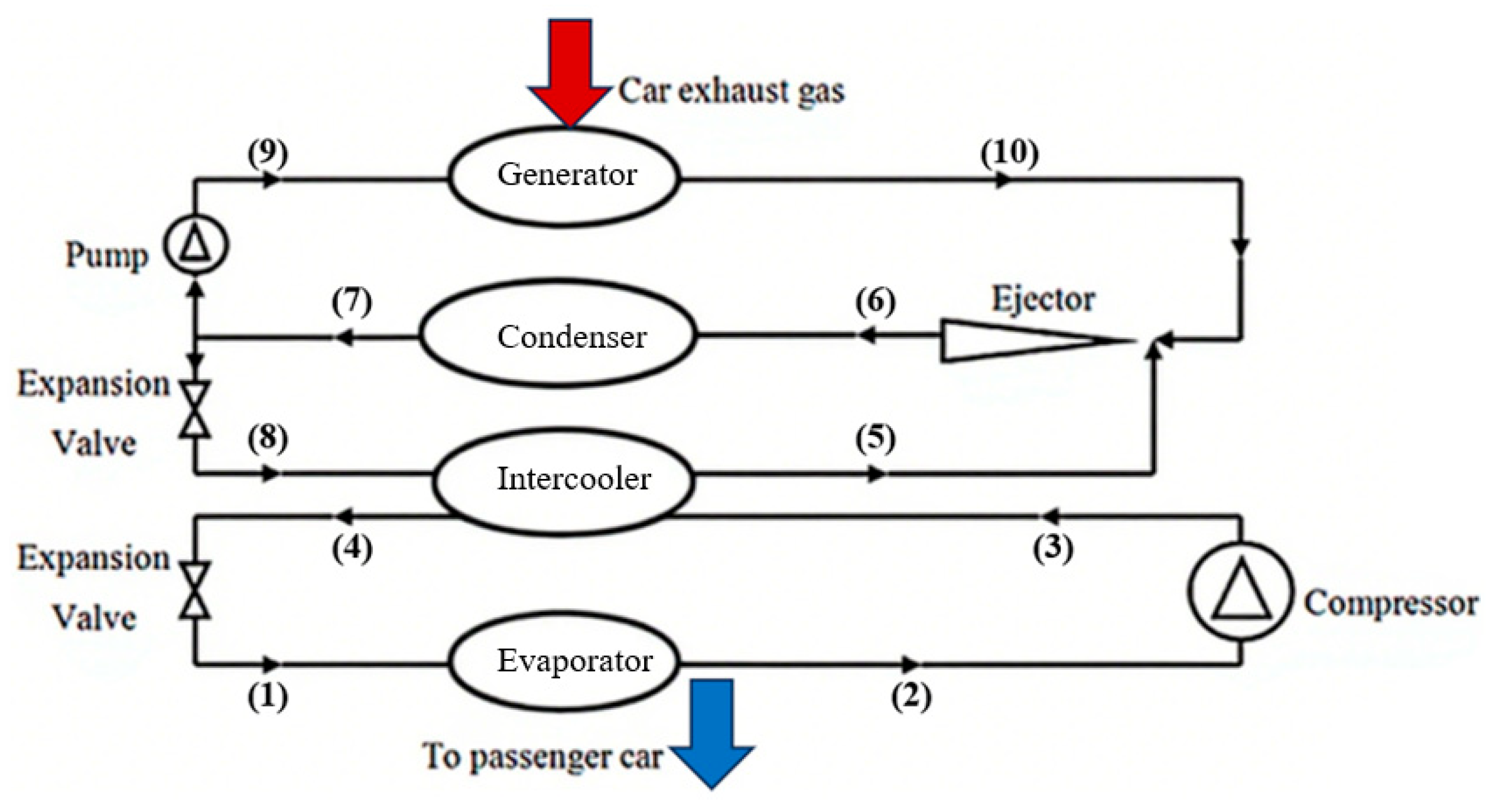
3.2. Research Progress of Ejector Refrigeration Air Conditioning System
3.2.1. Different Working Medium Ejector Refrigeration for Vehicles
3.2.2. Transcritical System of Vehicle Ejector
3.2.3. Structure and Parameter Optimization of Vehicle Ejector
4. Application of Ejector in Hydrogen Supply System for Fuel Cell Engine
4.1. Progress on Hydrogen Supply Systems for Fuel Cell Engines
4.1.1. Progress on Early-Stage Hydrogen Supply Systems for Fuel Cell Engines
4.1.2. Progress on Recent Hydrogen Supply Systems for Fuel Cell Engines
4.2. Parameter Optimization and Structural Innovation of Hydrogen Ejector
4.2.1. Optimization of Geometrical Parameter and Structure of Hydrogen Ejectors
4.2.2. Innovation of Adjustable Structure of Hydrogen Ejector
4.2.3. Multi-Nozzle Cooperative Structure of Hydrogen Ejector
5. Application of Ejector in New Pressure Reduction System for Compressed Air-Powered Vehicles
5.1. Progress in Air-Powered Vehicles and Compressed Air Energy Storage
5.2. System Integration Optimization of Air Ejector
6. Other Applications of Ejectors in the Field of Rail Transit
6.1. Pantograph Pneumatic System
6.2. Train Vacuum Toilet System
6.3. Train Ventilation System
6.4. Rail Transit Cleaning and Maintenance Device
7. Conclusions
- (1)
- Vehicle ejector refrigeration air conditioning is driven by vehicle waste heat energy and utilizes ejector refrigeration technology to replace the traditional compressed refrigeration system in automobiles. This system can reduce the energy consumption of the air conditioning system by 12~17%. Its application has important economic and social benefits for improving the primary energy utilization rate.
- (2)
- The hydrogen ejector serves as the core component of the fuel cell engine’s hydrogen supply. It not only improves engine performance but also significantly reduces emissions, resulting in a 9% reduction in high-pressure hydrogen demand. It represents one of the key technologies for realizing zero-emission vehicles.
- (3)
- In pneumatic vehicle pressure reduction systems, throttle valves are replaced by air ejectors, a design modification that increases system output power by more than 13%.
- (4)
- In pantograph pneumatic systems, the lift force is dynamically adjusted by ±20N at 300km/h through self-supply gas ejection technology. Vacuum toilet systems exceed 50% by intelligent sensing and variable vacuum ejectors. Ventilation systems improve thermal efficiency by 40% through the combination of multi-stage ejection and personalized nozzle design. Track cleaning devices efficiently remove pollutants by adopting 1000 bar high-pressure ejector technology.
- (1)
- In rail transit engine waste heat recovery, the fixed geometry ejector readily enters subcritical mode under variable engine operating conditions, causing the cooling capacity to be suddenly reduced and the coefficient of performance to be significantly attenuated. Data scarcity exists for global warming potential working fluids applied in the transcritical cycles. The coefficient of performance of traditional compression refrigeration systems is much lower than the theoretical value for ejector refrigeration, limiting the system’s actual energy efficiency improvement.
- (2)
- In hydrogen ejector technology, insufficient stability of hydrogen recycling under wide power output causes anodic pressure fluctuations exceeding ±0.15 bar during transient conditions. Mixing uniformity decreases at high load, resulting in the system’s net efficiency decaying to 58.6%. The ejection ratio fluctuates more than 7.3% when starting at low temperatures, while hydrogen recovery efficiency reaches only 97.2%.
- (3)
- In pressure reduction systems for new compressed air-powered vehicles, turbulence loss is caused by thermodynamic irreversibility, with conventional pressure relief valves inducing 50% energy loss. Although the ejector increases power output by 13%, the system round-trip efficiency is only 57.94%. Synergistic contradictions exist between lightweight gas storage and thermal management.
- (4)
- In other rail transit applications, a prominent contradiction exists between ejector noise reduction and energy consumption balance in the pantograph pneumatic system. Although the bilateral ejector reduces narrowband noise by 5 dB, wideband noise above 1 kHz is triggered. Insufficient vacuum stability occurs in the vacuum toilet system under low load conditions, while scaling-induced performance reduction is observed. The ventilation system’s airflow distribution uniformity requires optimization. The insufficient high-speed cleaning durability of the high-pressure ejector cleaning device easily allows pollutant reproduction.
8. Future Perspectives
- (1)
- Through dynamic intelligent regulation and structural innovation, a machine learning-based ejector pressure threshold prediction algorithm should be developed to improve variable working condition adaptability. A nested double-nozzle ejector requires a different design to extend power coverage. An adjustable swirl nozzle and mobile needle valve structure should be developed to achieve dynamic flow matching. Multi-nozzle flow field interference suppression technology should be further developed.
- (2)
- Through multi-system energy efficiency collaborative optimization, a hybrid pneumatic–electric architecture integrating residual pressure recovery and a multi-level decompression strategy should be established. Integration between fuel cell hydrogen supply systems and refueling station ejectors requires enhancement to improve hydrogen recycling efficiency. The cylinder liner water-driven ejector cooling system is to be strengthened to reduce the exhaust exergy loss rate.
- (3)
- Through the application of transcritical cycles and environmentally friendly working medium, research on CO2 transcritical ejector refrigeration systems can be deepened through backpressure optimization to improve round-trip efficiency. The injectivity characteristics of global warming potential working fluids require investigation under wide operating conditions to enhance the coefficient of performance. Ammonia working medium applications are to be expanded in low-temperature refrigerated transit to overcome the environmental limitations of conventional refrigerants.
- (4)
- Through the construction of a multi-physics field simulation platform integrating computational fluid dynamics and electrochemical mechanisms (e.g., fuel cell multiphase flow coupling), an ejector-stack cooperative model should be established to overcome hydrogen recirculation instability across wide power ranges.
Author Contributions
Funding
Conflicts of Interest
Nomenclature
| ER | Entrainment ratio |
| PEMFC | Proton exchange membrane fuel cell |
| COP | Coefficient of performance |
| ML | artificial intelligence |
| AI | Machine learning |
| ANNs | Artificial neural networks |
| Gas | Genetic algorithms |
| AR | Area ratio |
| NXP | Nozzle exit position |
| CFD | Computational fluid dynamics |
| PIV | Particle image velocimetry |
| ODP | Ozone depletion potential |
| GWP | Global warming potential |
| FCV | Fuel cell vehicle |
| APV | Air-powered vehicle |
| A-CAES | Adiabatic compressed air energy storage |
| SOFC | Solid oxide fuel cell |
| Ratio of entrained fluid flow rate | |
| Motive fluid flow rate | |
| N | Pressure ratio |
| Diffuser discharge pressure | |
| Suction fluid pressure | |
| Motive fluid pressure | |
| η | Efficiency of ejector |
| Output power | |
| Input power |
References
- Bahman, N.; Alalaiwat, D.; Abdulmohsen, Z.; Al Khalifa, M.; Al Baharna, S.; Al-Mannai, M.A.; Younis, A. A critical review on global CO2 emission: Where do industries stand? Rev. Environ. Health 2022, 38, 681–696. [Google Scholar] [CrossRef] [PubMed]
- Sadeghi, M.; Yari, M.; Mahmoudi, S.; Jafari, M. Thermodynamic analysis and optimization of a novel combined power and ejector refrigeration cycle—Desalination system. Appl. Energy 2017, 208, 239–251. [Google Scholar] [CrossRef]
- Li, D.; Groll, E.A. Transcritical CO2 refrigeration cycle with ejector-expansion device. Int. J. Refrig. 2005, 28, 766–773. [Google Scholar] [CrossRef]
- Khafaji, H.; Shahsavand, A.; Shooshtari, S.H.R. Simultaneous optimization of crude oil refinery vacuum distillation column and corresponding ejector system. Energy 2024, 294, 130702. [Google Scholar] [CrossRef]
- Chen, H.; Cai, C.; Jiang, S.; Zhang, H. Numerical modeling on installed performance of turbofan engine with inlet ejector. Aerosp. Sci. Technol. 2021, 112, 106590. [Google Scholar] [CrossRef]
- Takeya, Y.; Miwa, S.; Hibiki, T.; Mori, M. Application of steam injector to improved safety of light water reactors. Prog. Nucl. Energy 2015, 78, 80–100. [Google Scholar] [CrossRef]
- Mohammed, R.H.; Qasem, N.A.; Zubair, S.M. Enhancing the thermal and economic performance of supercritical CO2 plant by waste heat recovery using an ejector refrigeration cycle. Energy Convers. Manag. 2020, 224, 113340. [Google Scholar] [CrossRef]
- Galindo, J.; Dolz, V.; Tiseira, A.; Ponce-Mora, A. Thermodynamic analysis and optimization of a jet ejector refrigeration cycle used to cool down the intake air in an IC engine. Int. J. Refrig. 2019, 103, 253–263. [Google Scholar] [CrossRef]
- Feng, J.; Han, J.; Pang, Z.; Peng, X. Designing Hydrogen Recirculation Ejectors for Proton Exchange Membrane Fuel Cell Systems. Energies 2023, 16, 1201. [Google Scholar] [CrossRef]
- Guo, Z. An energy conservation design in vacuum sanitation systems. In Proceedings of the 2011 International Conference on Electronics, Communications and Control (ICECC), Ningbo, China, 9–11 September 2011. [Google Scholar]
- Han, J.; Feng, J.; Hou, T.; Peng, X. Performance investigation of a multi-nozzle ejector for proton exchange membrane fuel cell system. Int. J. Energy Res. 2021, 45, 3031–3048. [Google Scholar] [CrossRef]
- Elmore, E.; Al-Mutairi, K.; Hussain, B.; El-Gizawy, A.S. Development of Analytical Model for Predicting Dual-Phase Ejector Performance. In Proceedings of the International Mechanical Engineering Congress and Exposition, Phoenix, AZ, USA, 11–17 November 2016. [Google Scholar]
- Winoto, S.H.; Li, H.; Shah, D.A. Efficiency of Jet Pumps. J. Hydraul. Eng. 2000, 126, 150–156. [Google Scholar] [CrossRef]
- Karassik, I.J. Pump Handbook; McGraw-Hill: New York, NY, USA, 2001. [Google Scholar]
- Ünal, Ş.; Tuncay, Y. Thermodynamic analysis of the two-phase ejector air-conditioning system for buses. Appl. Therm. Eng. 2015, 79, 108–116. [Google Scholar] [CrossRef]
- Baek, S.; Ko, S.; Song, S.; Ryu, S. Numerical study of high-speed two-phase ejector performance with R134a refrigerant. Int. J. Heat Mass Transf. 2018, 126, 1071–1082. [Google Scholar] [CrossRef]
- Bai, T.; Yan, G.; Yu, J. Experimental investigation on the dynamic malfunction behavior of the two-phase ejector in a modified auto-cascade freezer refrigeration system. Energy Convers. Manag. 2019, 183, 382–390. [Google Scholar] [CrossRef]
- Chen, W.; Shi, C.; Hu, M.; Chong, D.; Wang, J.; Yan, J. Numerical and Experimental Analysis of Two Phase Flow in Ejector. Energy Procedia 2014, 61, 1298–1301. [Google Scholar] [CrossRef]
- Yang, Y.; Zhu, X.; Yan, Y.; Ding, H.; Wen, C. Performance of supersonic steam ejectors considering the nonequilibrium condensation phenomenon for efficient energy utilisation. Appl. Energy 2019, 242, 157–167. [Google Scholar] [CrossRef]
- Li, Y.; Deng, J.; Ma, L. Experimental study on the primary flow expansion characteristics in transcritical CO2 two-phase ejectors with different primary nozzle diverging angles. Energy 2019, 186, 115839. [Google Scholar] [CrossRef]
- Petrovic, A.; Delibasic, B.; Filipovic, J.; Petrovic, A.; Lomovic, M. Thermoeconomic and environmental optimization of geothermal water desalination plant with ejector refrigeration system. Energy Convers. Manag. 2018, 178, 65–77. [Google Scholar] [CrossRef]
- Kumar, V.; Singhal, G.; Subbarao, P. Realization of novel constant rate of kinetic energy change (CRKEC) supersonic ejector. Energy 2018, 164, 694–706. [Google Scholar] [CrossRef]
- Yadav, S.; Pandey, K.; Kumar, V.; Gupta, R. Computational analysis of a supersonic two-stage ejector. Mater. Today Proc. 2021, 38, 2700–2705. [Google Scholar] [CrossRef]
- Haida, M.; Smolka, J.; Hafner, A.; Mastrowski, M.; Palacz, M.; Madsen, K.B.; Nowak, A.J.; Banasiak, K. Numerical investigation of heat transfer in a CO2 two-phase ejector. Energy 2018, 163, 682–698. [Google Scholar] [CrossRef]
- Al-Doori, G.; Saleh, K.; Al-Manea, A.; Al-Rbaihat, R.; Altork, Y.; Alahmer, A. A review of axial and radial ejectors: Geometric design, computational analysis, performance, and machine learning approaches. Appl. Therm. Eng. 2025, 266, 125694. [Google Scholar] [CrossRef]
- Liu, G.; Zhao, H.; Deng, J.; Wang, L.; Zhang, H. Performance improvement of CO2 two-phase ejector by combining CFD modeling, artificial neural network and genetic algorithm. Int. J. Refrig. 2023, 154, 151–167. [Google Scholar] [CrossRef]
- Zhang, K.; Zhang, Z.; Han, Y.; Gu, Y.; Qiu, Q.; Zhu, X. Artificial neural network modeling for steam ejector design. Appl. Therm. Eng. 2022, 204, 117939. [Google Scholar] [CrossRef]
- Ringstad, K.E. CFD Modelling for Improved Components in CO2 and Ammonia Vapour Compression Systems. Ph.D. Thesis, Norwegian University of Science and Technology, Trondheim, Norway, 2023. [Google Scholar]
- Wang, H.; Cai, W.; Wang, Y. Optimization of a hybrid ejector air conditioning system with PSOGA. Appl. Therm. Eng. 2017, 112, 1474–1486. [Google Scholar] [CrossRef]
- Li, Y.; Deng, J.; He, Y. Numerical study on the interaction of geometric parameters of a transcritical CO2 two-phase ejector using response surface methodology and genetic algorithm. Appl. Therm. Eng. 2022, 214, 118799. [Google Scholar] [CrossRef]
- Bencharif, M.; Croquer, S.; Fang, Y.; Poncet, S.; Nesreddine, H.; Zid, S. Prediction of Performance and Geometrical Parameters of Single-Phase Ejectors Using Artificial Neural Networks. Thermo 2023, 3, 1–20. [Google Scholar] [CrossRef]
- Al-Manea, A.; Buttsworth, D.; Saleh, K.; Malpress, R.; Leis, J. Measurement of turbulent supersonic steam jet flow characteristics using TDLAS. Flow Meas. Instrum. 2022, 87, 102212. [Google Scholar] [CrossRef]
- Dvořák, V.; Kotek, M. PIV measurement of constant area mixing in subsonic air ejector. EPJ Web Conf. 2012, 25, 01011. [Google Scholar] [CrossRef]
- Chen, W.; Chong, D.; Yan, J.; Liu, J. The numerical analysis of the effect of geometrical factors on natural gas ejector performance. Appl. Therm. Eng. 2013, 59, 21–29. [Google Scholar] [CrossRef]
- Pradere, C.; Clerjaud, L.; Batsale, J.C.; Dilhaire, S. High speed heterodyne infrared thermography applied to thermal diffusivity identification. Rev. Sci. Instrum. 2011, 82, 054901. [Google Scholar] [CrossRef] [PubMed]
- Han, Y.; Wang, X.; Sun, H.; Zhang, G.; Guo, L.; Tu, J. CFD simulation on the boundary layer separation in the steam ejector and its influence on the pumping performance. Energy 2019, 167, 469–483. [Google Scholar] [CrossRef]
- Sumeru, K.; Martin, L.; Ani, F.N.; Nasution, H. Energy Savings in Air Conditioning System Using Ejector: An Overview. Appl. Mech. Mater. 2014, 493, 93–98. [Google Scholar] [CrossRef]
- Sumeru; Nasution, H.; Ani, F.N. The application of gas ejector for road transport air conditioning system. AIP Conf. Proc. 2012, 1440, 1133–1140. [Google Scholar] [CrossRef]
- Wang, L.; Cai, W.; Zhao, H.; Lin, C.; Yan, J. Experimentation and cycle performance prediction of hybrid A/C system using automobile exhaust waste heat. Appl. Therm. Eng. 2016, 94, 314–323. [Google Scholar] [CrossRef]
- Suresh, R.; Prakash, R.; Praveen, V.; Datta, S.P. Numerically Optimized Ejector Geometry for Ejector Refrigeration Systems With Low-Global Warming Potential Working Fluids. J. Energy Resour. Technol. 2024, 146, 101702. [Google Scholar] [CrossRef]
- Keeratiyadathanapat, N.; Sriveerakul, T.; Suvarnakuta, N.; Pianthong, K. Experimental and Theoretical Investigation of a Hybrid Compressor and Ejector Refrigeration System for Automotive Air Conditioning Application. Eng. J. 2017, 21, 105–123. [Google Scholar] [CrossRef]
- Takeuchi, H.; Nishijima, H.; Ikemoto, T. World’s First High Efficiency Refrigeration Cycle with Two-Phase Ejector:“EJECTOR CYCLE”; SAE Technical Papers 2004-01-0916; SAE International: Warrendale, PA, USA, 2004. [Google Scholar]
- Oshitani, H.; Gocho, M.; Takano, Y. Ejector-Type Cool Box. SAE Int. J. Passeng. Cars—Mech. Syst. 2008, 1, 640–645. [Google Scholar] [CrossRef]
- Zegenhagen, M.; Ziegler, F. Feasibility analysis of an exhaust gas waste heat driven jet-ejector cooling system for charge air cooling of turbocharged gasoline engines. Appl. Energy 2015, 160, 221–230. [Google Scholar] [CrossRef]
- Zhu, J.; Elbel, S. A New Control Mechanism for Two-Phase Ejector in Vapor Compression Cycles for Automotive Applications Using Adjustable Motive Nozzle Inlet Swirl. SAE Int. J. Passeng. Cars—Mech. Syst. 2016, 9, 44–51. [Google Scholar] [CrossRef]
- Ünal, Ş.; Erdinç, M.T.; Kutlu, Ç. Optimal thermodynamic parameters of two-phase ejector refrigeration system for buses. Appl. Therm. Eng. 2017, 124, 1354–1367. [Google Scholar] [CrossRef]
- Syaukani, M.; Lech, S.; Daniarta, S.; Kolasiński, P. A Systematic Review of Two-Phase Expansion Losses: Challenges, Optimization Opportunities, and Future Research Directions. Energies 2025, 18, 3504. [Google Scholar] [CrossRef]
- Jaruwongwittaya, T.; Chen, G. Application of Two Stage Ejector Cooling System in a Bus. Energy Procedia 2012, 14, 187–197. [Google Scholar] [CrossRef]
- Lawrence, N.; Elbel, S. Experimental and analytical investigation of automotive ejector air-conditioning cycles using low-pressure refrigerants. In Proceedings of the International Refrigeration and Air Conditioning Conference, West Lafayette, IN, USA, 16–19 July 2012. [Google Scholar]
- Sukri, M.F.; Musa, M.N.; Senawi, M.Y.; Nasution, H. Achieving a better energy-efficient automotive air-conditioning system: A review of potential technologies and strategies for vapor compression refrigeration cycle. Energy Effic. 2015, 8, 1201–1229. [Google Scholar] [CrossRef]
- Galindo, J.; Gil, A.; Dolz, V.; Ponce-Mora, A. Numerical Optimization of an Ejector for Waste Heat Recovery Used to Cool Down the Intake Air in an Internal Combustion Engine. J. Therm. Sci. Eng. Appl. 2020, 12, 051024. [Google Scholar] [CrossRef]
- Venkataraman, V.; El-Kharouf, A.; Pandya, B.; Amakiri, E.; Steinberger-Wilckens, R. Coupling of engine exhaust and fuel cell exhaust with vapour absorption refrigeration/air conditioning systems for transport applications: A review. Therm. Sci. Eng. Prog. 2020, 18, 100550. [Google Scholar] [CrossRef]
- Pan, M.; Bian, X.; Zhu, Y.; Liang, Y.; Lu, F.; Xiao, G. Thermodynamic analysis of a combined supercritical CO2 and ejector expansion refrigeration cycle for engine waste heat recovery. Energy Convers. Manag. 2020, 224, 113373. [Google Scholar] [CrossRef]
- Chen, Y.; Zou, H.; Dong, J.; Xu, H.; Tian, C.; Butrymowicz, D. Experimental investigation on refrigeration performance of a CO2 system with intermediate cooling for automobiles. Appl. Therm. Eng. 2020, 174, 115267. [Google Scholar] [CrossRef]
- Song, Y.; Cui, C.; Yin, X.; Cao, F. Advanced development and application of transcritical CO2 refrigeration and heat pump technology—A review. Energy Rep. 2022, 8, 7840–7869. [Google Scholar] [CrossRef]
- Ipakchi, O.; Mosaffa, A.; Farshi, L.G. Ejector based CO2 transcritical combined cooling and power system utilizing waste heat recovery: A thermoeconomic assessment. Energy Convers. Manag. 2019, 186, 462–472. [Google Scholar] [CrossRef]
- Wu, C.; Wan, Y.; Xu, X.; Liu, C. A transcritical carbon dioxide power cycle enhanced by ejector refrigeration for engine waste heat recovery: Comprehensive analysis and optimization. Energy Convers. Manag. 2023, 292, 117428. [Google Scholar] [CrossRef]
- Xue, H.; Wang, L.; Zhang, H.; Jia, L.; Ren, J. Design and investigation of multi-nozzle ejector for PEMFC hydrogen recirculation. Int. J. Hydrogen Energy 2020, 45, 14500–14516. [Google Scholar] [CrossRef]
- Rogié, B.; Kærn, M.R.; Wen, C.; Rothuizen, E. Numerical optimization of a novel gas-gas ejector for fuelling of hydrogen vehicles. Int. J. Hydrogen Energy 2020, 45, 21905–21919. [Google Scholar] [CrossRef]
- Han, J.; Feng, J.; Chen, P.; Liu, Y.; Peng, X. A review of key components of hydrogen recirculation subsystem for fuel cell vehicles. Energy Convers. Manag. X 2022, 15, 100265. [Google Scholar] [CrossRef]
- Wen, C.; Rogie, B.; Kærn, M.R.; Rothuizen, E. A first study of the potential of integrating an ejector in hydrogen fuelling stations for fuelling high pressure hydrogen vehicles. Appl. Energy 2020, 260, 113958. [Google Scholar] [CrossRef]
- Marsano, F.; Magistri, L.; Massardo, A. Ejector performance influence on a solid oxide fuel cell anodic recirculation system. J. Power Sources 2004, 129, 216–228. [Google Scholar] [CrossRef]
- Kim, Y.Y.; Lee, J.T.; Caton, J.A. The Development of a Dual-Injection Hydrogen-Fueled Engine With High Power and High Efficiency. J. Eng. Gas Turbines Power 2005, 128, 203–212. [Google Scholar] [CrossRef]
- Karnik, A.Y.; Sun, J.; Buckland, J.H. Control analysis of an ejector based fuel cell anode recirculation system. In Proceedings of the 2006 American Control Conference, Minneapolis, MN, USA, 14–16 June 2006. [Google Scholar]
- Wee, J.-H. Applications of proton exchange membrane fuel cell systems. Renew. Sustain. Energy Rev. 2007, 11, 1720–1738. [Google Scholar] [CrossRef]
- Ahluwalia, R.K.; Wang, X. Fuel cell systems for transportation: Status and trends. J. Power Sources 2008, 177, 167–176. [Google Scholar] [CrossRef]
- Zhu, Y.; Li, Y. New theoretical model for convergent nozzle ejector in the proton exchange membrane fuel cell system. J. Power Sources 2009, 191, 510–519. [Google Scholar] [CrossRef]
- Kuo, J.-K.; Jiang, W.-Z.; Li, C.-H.; Hsu, T.-H. Numerical investigation into hydrogen supply stability and I-V performance of PEM fuel cell system with passive Venturi ejector. Appl. Therm. Eng. 2020, 169, 114908. [Google Scholar] [CrossRef]
- Zhao, Y.; Liu, Y.; Liu, G.; Yang, Q.; Li, L.; Gao, Z. Air and hydrogen supply systems and equipment for PEM fuel cells: A review. Int. J. Green Energy 2022, 19, 331–348. [Google Scholar] [CrossRef]
- Chen, L.; Xu, K.; Yang, Z.; Yan, Z.; Dong, Z. Optimal Design and Operation of Dual-Ejector PEMFC Hydrogen Supply and Circulation System. Energies 2022, 15, 5427. [Google Scholar] [CrossRef]
- Chen, L.; Xu, K.; Yang, Z.; Yan, Z.; Zhai, C.; Dong, Z. Optimal design of a novel nested-nozzle ejector for PEMFC’s hydrogen supply and recirculation system. Int. J. Hydrogen Energy 2023, 48, 27330–27343. [Google Scholar] [CrossRef]
- Dadvar, M.; Afshari, E. Analysis of design parameters in anodic recirculation system based on ejector technology for PEM fuel cells: A new approach in designing. Int. J. Hydrogen Energy 2014, 39, 12061–12073. [Google Scholar] [CrossRef]
- Kuo, J.-K.; Hsieh, C.-Y. Numerical investigation into effects of ejector geometry and operating conditions on hydrogen recirculation ratio in 80 kW PEM fuel cell system. Energy 2021, 233, 121100. [Google Scholar] [CrossRef]
- Yin, B.; Li, Z.; Dong, F.; Xu, S.; Ni, H. A novel dual-nozzle ejector for enhancement of hydrogen recirculation applied to proton exchange membrane fuel cell system. J. Power Sources 2023, 580, 233444. [Google Scholar] [CrossRef]
- Antetomaso, C.; Irimescu, A.; Merola, S.; Vaglieco, B.; Di Micco, S.; Jannelli, E. Ejector design for PEM fuel cells and assessment of its scalability. Int. J. Hydrogen Energy 2024, 95, 1235–1241. [Google Scholar] [CrossRef]
- Ding, H.; Zhang, P.; Dong, Y.; Yang, Y. Optimization of hydrogen recirculation ejector for proton-exchange membrane fuel cells (PEMFC) systems considering non-equilibrium condensation. Renew. Energy 2024, 237, 121748. [Google Scholar] [CrossRef]
- Arabbeiki, M.; Mansourkiaei, M.; Ferrero, D.; Santarelli, M. Numerical optimization of ejector for enhanced hydrogen recirculation in proton exchange membrane fuel cells. J. Power Sources 2025, 641, 236846. [Google Scholar] [CrossRef]
- Brunner, D.A.; Marcks, S.; Bajpai, M.; Prasad, A.K.; Advani, S.G. Design and characterization of an electronically controlled variable flow rate ejector for fuel cell applications. Int. J. Hydrogen Energy 2012, 37, 4457–4466. [Google Scholar] [CrossRef]
- Jenssen, D.; Berger, O.; Krewer, U. Improved PEM fuel cell system operation with cascaded stack and ejector-based recirculation. Appl. Energy 2017, 195, 324–333. [Google Scholar] [CrossRef]
- Seth, B.; Knecht, S.; Szalai, M.; Haußmann, J. Design of a variable passive ejector for hydrogen recirculation of a PEM fuel cell system. Int. J. Hydrogen Energy 2025, 99, 956–965. [Google Scholar] [CrossRef]
- Song, Y.; Wang, X.; Wang, L.; Pan, F.; Chen, W.; Xi, F. A twin-nozzle ejector for hydrogen recirculation in wide power operation of polymer electrolyte membrane fuel cell system. Appl. Energy 2021, 300, 117442. [Google Scholar] [CrossRef]
- Zhuang, H. Performance Study of Ejector-Based Compressed Air-Powered Vehicles. Beijing University of Technology. 2012. Available online: https://kns.cnki.net/kcms2/article/abstract?v=5ykJdPmCibI5N-v0eYBRcECQf9ijLvfos5Tq8EpxPOh463VuVYqM4Tm7iu2ikIs-l-uvh2VIpXJsqAHV-FKraLKsTEGi6IDTq2wPk2NkGnWklJ0tAqUEwsqBwxH32nL4DNYee-9AUTOzLRLF_LluuzCVsHXrNK0nSfm20nJzYRAcA2tm0-WmQtBLz7QgrbV-&uniplatform=NZKPT&language=CHS (accessed on 23 July 2025).
- Shi, Y.; Li, F.; Cai, M.; Yu, Q. Literature review: Present state and future trends of air-powered vehicles. J. Renew. Sustain. Energy 2016, 8, 025704. [Google Scholar] [CrossRef]
- Verma, S.S. Air Powered Vehicles. Open Fuels Energy Sci. J. 2008, 1, 54–56. [Google Scholar] [CrossRef]
- Papson, A.; Creutzig, F.; Schipper, L. Compressed Air Vehicles: Drive-Cycle Analysis of Vehicle Performance, Environmental Impacts, and Economic Costs. Transp. Res. Rec. 2010, 2191, 67–74. [Google Scholar] [CrossRef]
- Marvania, D.; Subudhi, S. A comprehensive review on compressed air powered engine. Renew. Sustain. Energy Rev. 2017, 70, 1119–1130. [Google Scholar] [CrossRef]
- Wasbari, F.; Bakar, R.; Gan, L.; Tahir, M.; Yusof, A. A review of compressed-air hybrid technology in vehicle system. Renew. Sustain. Energy Rev. 2017, 67, 935–953. [Google Scholar] [CrossRef]
- Guo, Z.; Deng, G.; Fan, Y.; Chen, G. Performance optimization of adiabatic compressed air energy storage with ejector technology. Appl. Therm. Eng. 2016, 94, 193–197. [Google Scholar] [CrossRef]
- Chen, L.X.; Hu, P.; Zhao, P.P.; Na Xie, M.; Wang, D.X.; Wang, F.X. A novel throttling strategy for adiabatic compressed air energy storage system based on an ejector. Energy Convers. Manag. 2018, 158, 50–59. [Google Scholar] [CrossRef]
- Zhou, S.; He, Y.; Chen, H.; Xu, Y.; Deng, J. Performance analysis of a novel adiabatic compressed air energy system with ejectors enhanced charging process. Energy 2020, 205, 118050. [Google Scholar] [CrossRef]
- Jankowski, M.; Pałac, A.; Sornek, K.; Goryl, W.; Żołądek, M.; Homa, M.; Filipowicz, M. Status and Development Perspectives of the Compressed Air Energy Storage (CAES) Technologies—A Literature Review. Energies 2024, 17, 2064. [Google Scholar] [CrossRef]
- Rabi, A.M.; Radulovic, J.; Buick, J.M. Radulovic and J. Buick, Comprehensive Review of Compressed Air Energy Storage (CAES) Technologies. Thermo 2023, 3, 104–126. [Google Scholar] [CrossRef]
- Liu, T.; Wu, S.; Zhong, L.; Yao, E.; Hu, Y.; Xi, G. Parametric assessment and multi-objective optimization of an ejector-enhanced compressed air energy storage system based on conventional and advanced exergy. J. Renew. Sustain. Energy 2024, 16, 054101. [Google Scholar] [CrossRef]
- Sadeghi, S.; Ahmadi, P. Thermo-economic optimization of a high-performance CCHP system integrated with compressed air energy storage (CAES) and carbon dioxide ejector cooling system. Sustain. Energy Technol. Assess. 2021, 45, 101112. [Google Scholar] [CrossRef]
- Cao, Z.; Zhou, S.; He, Y.; Xu, Y.; Chen, H.; Deng, J. Numerical study on adiabatic compressed air energy storage system with only one ejector alongside final stage compression. Appl. Therm. Eng. 2022, 216, 119071. [Google Scholar] [CrossRef]
- Yang, Y.; Wang, N.; Ren, X.; Li, Y.; Guo, X.; Zhang, K.; Shen, S. Research on similarity characteristics of critical states transferring of adjustable ejector. Int. J. Refrig. 2023, 148, 64–74. [Google Scholar] [CrossRef]
- Ikeda, M.; Yoshida, K.; Suzuki, M. Flow Control Technique to Modify the Aeroacoustic and Aerodynamic Characteristics of a High-Speed Pantograph by Ejection of Jets; Institute of Noise Control Engineering: Washington, DC, USA, 2004. [Google Scholar]
- Ikeda, M.; Suzuki, M.; Yoshida, K.; ITO, M. Application of Jet Ejection to Control Contact Force of Pantograph for High-speed Trains. In Proceedings of the 6th Symposium on Smart Control of Turbulence, Tokio, Japan, 6–9 March 2005; pp. 311–319. [Google Scholar]
- Suzuki, M.; Ikeda, M.; Koyama, T. Flow Control on Pantograph with Air Intake and Outlet. Q. Rep. RTRI 2007, 48, 236–239. [Google Scholar] [CrossRef]
- Huang, S.; Zhang, B.D.; Li, Z.W.; Zhao, J.P.; Peng, W.J.; Lin, J.R. Aerodynamic Characteristics of High-speed Train Pantographs Based on Jet Flow Control. J. Appl. Fluid Mech. 2024, 17, 1536–1551. [Google Scholar] [CrossRef]
- Guo, Z.; Li, X.; Kagawa, T. Sewerage force adjustment technology for energy conservation in vacuum sanitation systems. Chin. J. Mech. Eng. 2013, 26, 334–340. [Google Scholar] [CrossRef]
- Fujino, K.; Yamamoto, H.; Yamamoto, N.; Youn, C.; Kagawa, T.; Ito, M.; Xin, L.; Kawashima, K.; Taniguchi, K.; Yamamoto, H. Transient pressure and flow rate measurement of the vacuum toilet system for train. In Proceedings of the 8th JFPS International Symposium on Fluid Power, Okinawa, Japan, 25–28 October 2011. [Google Scholar]
- Fujino, K.; Yamamoto, H.; Yamamoto, N.; Youn, C.; Kagawa, T. Study of the energy consumption of a vacuum toilet system for train. In Proceedings of the 9th JFPS International Symposium Fluid Power, Matsue, Japan, 28–31 October 2014. [Google Scholar]
- Starcheous, Y.; Danileychenko, A.; Lupikov, K. Development of transport heating systems with cascade transformers of energy. Teka Kom. Motoryz. I Energetyki Rol. 2014, 14, 275–285. [Google Scholar]
- Iranzo, A.; Salva, J.A.; Guerra, J.; Barea, G.; Pino, F.J. Air Ventilation and Comfort in Railway Vehicles Operating in Ventilation Mode. J. Therm. Sci. Eng. Appl. 2019, 11, 031010. [Google Scholar] [CrossRef]
- Schmeling, D.; Zierke, O.; Maier, J.; Dehne, T.; Volkmann, A.; Marggraf-Micheel, C.; Goerke, P. Multi-jet personalized ventilation in passenger trains: Objective and subjective thermal comfort. Build. Environ. 2025, 270, 112510. [Google Scholar] [CrossRef]
- Vasic, G. New Rail Materials and Coatings; RRUK Report A(PRUK/A2/1); University of Sheffield: South Yorkshire, UK, 2003. [Google Scholar]


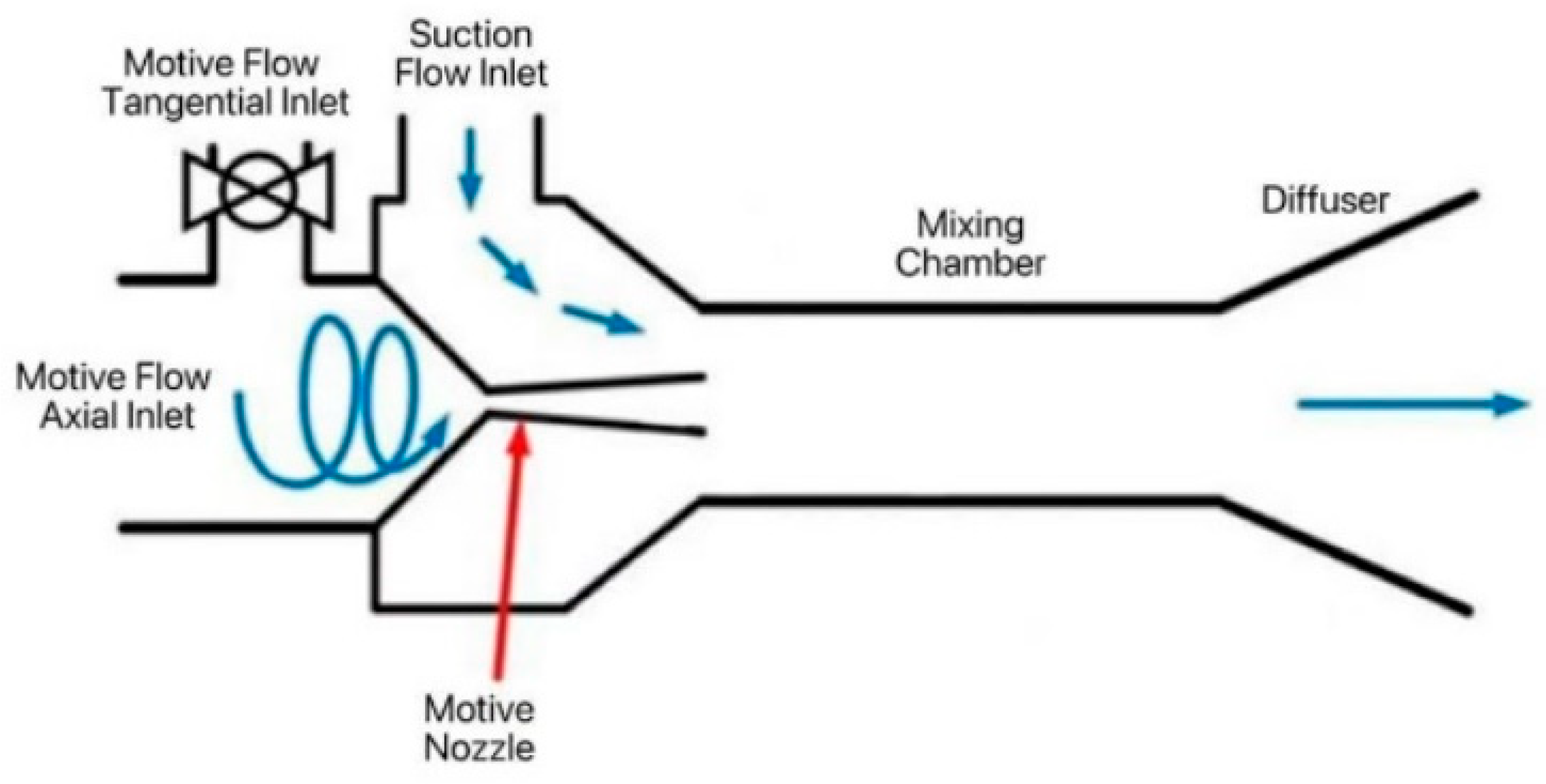
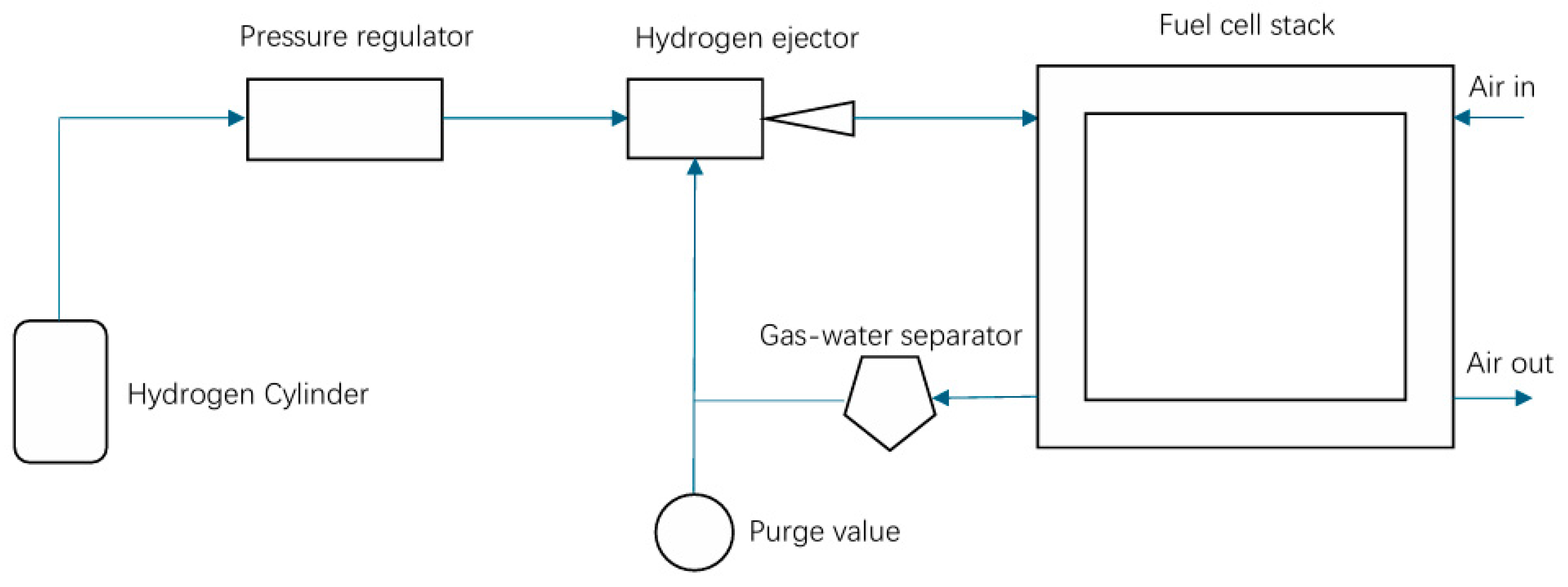
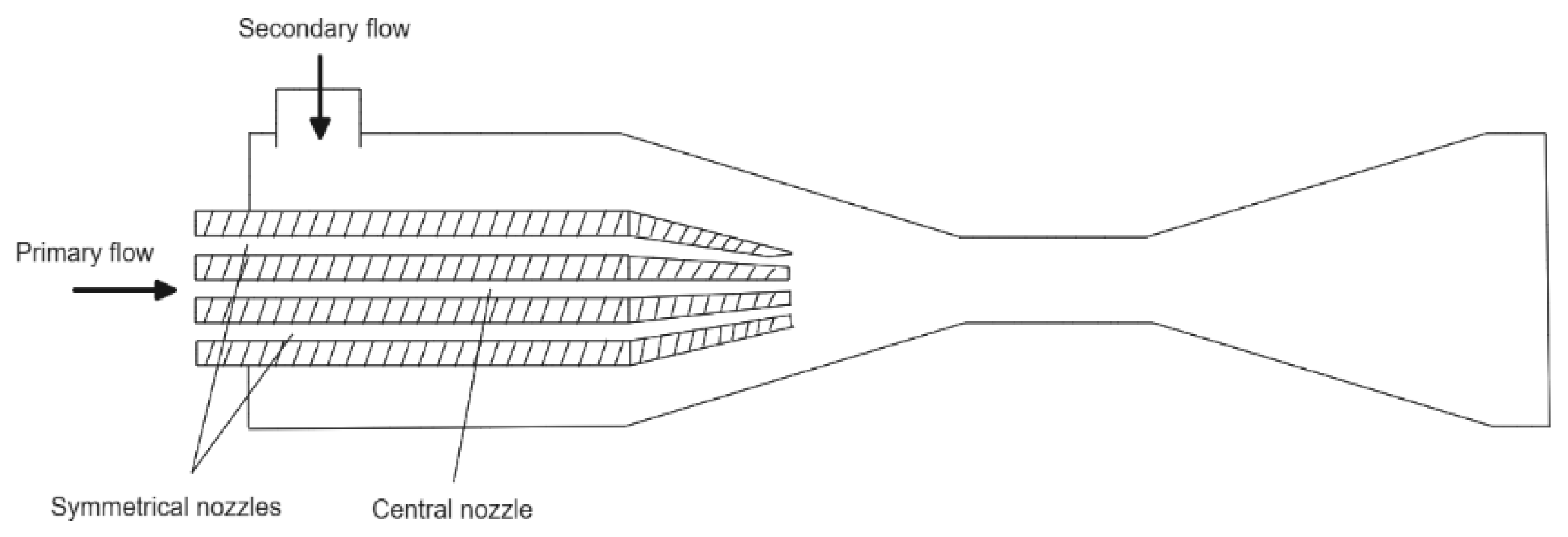
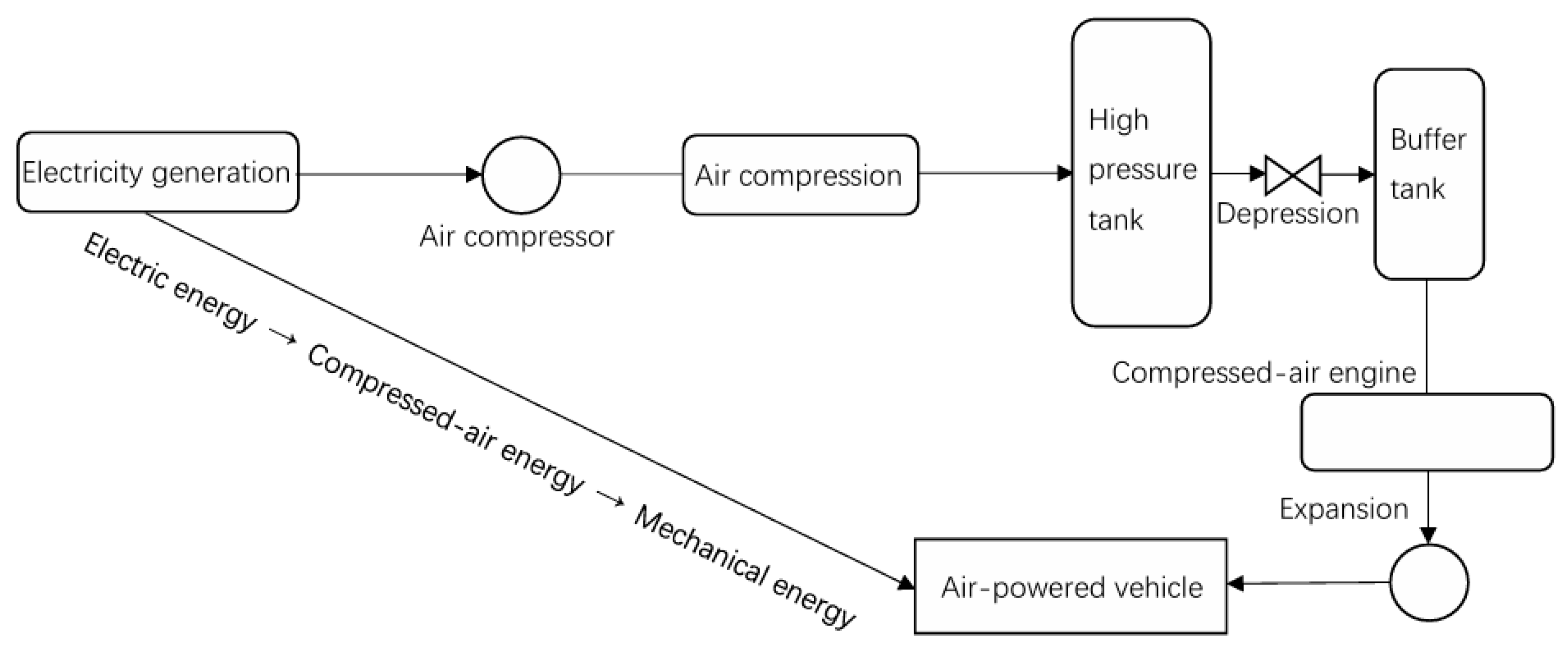
| Refrigerant | COP Gain/COP Value | ER | Energy Saving Effect |
|---|---|---|---|
| R134a | 10–20% [40] | - | AC energy consumption reduced by 12–17% [40] |
| R1234yf | Theoretical COP 1–3% > R134a [50] | 0.139 (optimized) [51] | Compressor power consumption reduced 15% [50] |
| Water | COP: 0.29–0.89 [48] | Optimized two-stage ER [48] | Engine load reduced >30% [41], fuel consumption and greenhouse gas emissions reduced |
| R32/CO2 Mixture | Integrated COP: 2.05 [53] | 1.39 [53] | Refrigeration capacity: 225.5 kW [53] |
| CO2 Transcritical | System COP increased 12.8% [54] Efficiency improved 16–35% [55] | - | Energy savings potential: 22.16% annually [55] |
| Application Domain | Specific Technology Focus | Future Research Direction |
|---|---|---|
| Waste heat recovery | Dynamic regulation and structural innovation | Developing machine learning-based ejector pressure threshold prediction algorithms; designing nested double-nozzle ejectors; creating adjustable swirl nozzles and mobile needle valve structures. |
| Hydrogen systems | Flow field optimization and system integration | Developing multi-nozzle flow field interference suppression technology; constructing multi-physics simulation platforms for ejector-stack cooperation. |
| Air-powered vehicle | System architecture and efficiency enhancement | Optimizing multi-level decompression strategies; designing thermally–mechanically coupled gas storage systems. |
Disclaimer/Publisher’s Note: The statements, opinions and data contained in all publications are solely those of the individual author(s) and contributor(s) and not of MDPI and/or the editor(s). MDPI and/or the editor(s) disclaim responsibility for any injury to people or property resulting from any ideas, methods, instructions or products referred to in the content. |
© 2025 by the authors. Licensee MDPI, Basel, Switzerland. This article is an open access article distributed under the terms and conditions of the Creative Commons Attribution (CC BY) license (https://creativecommons.org/licenses/by/4.0/).
Share and Cite
Li, Y.; Huang, H.; Shen, S.; Guo, Y.; Yang, Y.; Liu, S. Application Advances and Prospects of Ejector Technologies in the Field of Rail Transit Driven by Energy Conservation and Energy Transition. Energies 2025, 18, 3951. https://doi.org/10.3390/en18153951
Li Y, Huang H, Shen S, Guo Y, Yang Y, Liu S. Application Advances and Prospects of Ejector Technologies in the Field of Rail Transit Driven by Energy Conservation and Energy Transition. Energies. 2025; 18(15):3951. https://doi.org/10.3390/en18153951
Chicago/Turabian StyleLi, Yiqiao, Hao Huang, Shengqiang Shen, Yali Guo, Yong Yang, and Siyuan Liu. 2025. "Application Advances and Prospects of Ejector Technologies in the Field of Rail Transit Driven by Energy Conservation and Energy Transition" Energies 18, no. 15: 3951. https://doi.org/10.3390/en18153951
APA StyleLi, Y., Huang, H., Shen, S., Guo, Y., Yang, Y., & Liu, S. (2025). Application Advances and Prospects of Ejector Technologies in the Field of Rail Transit Driven by Energy Conservation and Energy Transition. Energies, 18(15), 3951. https://doi.org/10.3390/en18153951








